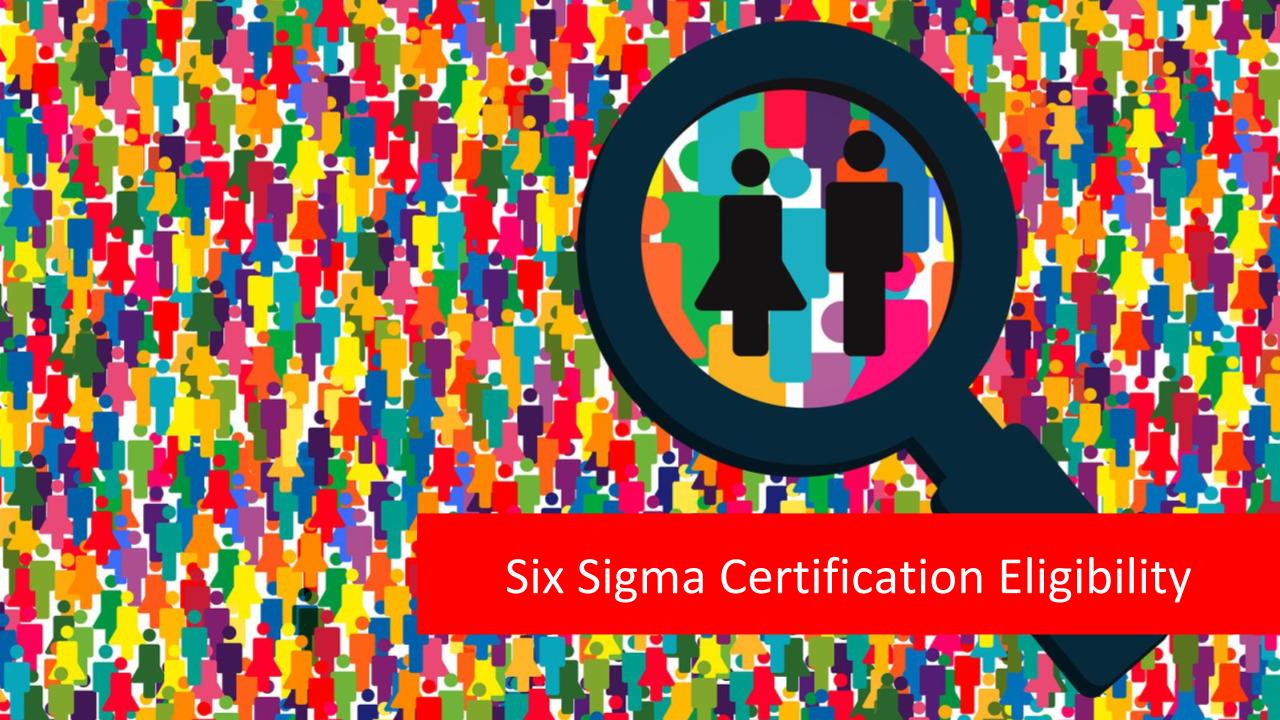Before we discuss the topic of Six Sigma Certification eligibility, let us throw some light on the background of this methodology. Six Sigma is arguably a very clever way of branding and packaging many aspects of Total Quality Management that exist in their own right, regardless of the development of Six Sigma. Six Sigma is lots of different things because it had different meanings over time, and also because it is now interpreted in increasingly different ways. And Six Sigma is still evolving.
Attend our 100% Online & Self-Paced Free Six Sigma Training.
Six Sigma is a data-driven method for achieving near perfect quality. Six Sigma analysis can focus on any element of production or service and has a strong emphasis on statistical analysis in design, manufacturing and customer-oriented activities.
This certification is very much similar to other professional courses. The normal certification flow in all courses is that after having cleared specified guidelines and followed the required procedure, individuals are certified as ‘Capable’ of employing the gained knowledge in their respective field. There are several stages of the Six Sigma certification program and with each qualifying level, certain tests have to be cleared. These levels are labeled in the same manner as a martial arts certification grade. There are various belts such as Green Belt, Black Belt and Master Black Belt awarded to professionals who complete corresponding stages of the course. And there are some eligibility requirements for each level. If you are considering your Six Sigma Certification eligibility, you may take a look in a free Six Sigma training as well.

Levels of Six Sigma Certification
The details of six sigma certification eligibility are as follows:
- Six Sigma Green Belt: Six Sigma certification eligibility begins with the green belt level. Six Sigma Green Belt certified practitioners are known as part-time change agents. They typically spend about 25 to 30 percent of their time contributing to Six Sigma projects and the remainder working in their respective operational areas. Six Sigma Green Belts are highly valued for the functional knowledge they bring to the project team. They are not only experts in Six Sigma, but; also experts in the process that they are improving. Six Sigma Green Belts help their project teams gather and analyze data, and play an important role in identifying and implementing improvements.
- You may acquire this certification after finishing a Lean Six Sigma Green Belt training.
Check our Six Sigma Training Video
- Six Sigma Black Belt: Black Belt certification is the second level in determining Six Sigma certification eligibility. Six Sigma Black Belt certified personnel lead project teams and act as mentors to individual team members. Leading Six Sigma projects is their primary responsibility and they practice it full-time. Qualifications for a Six Sigma Black Belt role include three to four years of relevant work experience and completion of two to three Six Sigma projects.
- Master Black Belt: Master Black Belt certification is the third and last level of Six Sigma certification eligibility. Master Black Belt certified personnel is the highest Six Sigma belts. They act as liaisons with senior management. Master Black Belts are technical experts. They are the six sigma authorities who coach, teach and mentor both project teams and corporate executives in the ways of Six Sigma.

How Does The Eligibility Change According to the Levels?
The eligibility is referred in terms of different levels of certification under Six Sigma methodology.
Six Sigma Eligibility: Six Sigma Green Belt Level
Honestly speaking, Six Sigma certification eligibility has no specific criterion for any level. Officially, the certification level begins with green belt certification. The eligibility criterion at the green belt level purely depends on the institution offering Green Belt certification. However; the industry, domain, and subject-matter experts have developed a generic criterion, in terms of pre-certification and post-certification effort & experience levels, to determine Six Sigma certification eligibility at the green belt level. Generic Six Sigma certification eligibility criterion can be described in the following manner:
- The First Six Sigma certification eligibility criteria is to be willing to spend some of their production time, at least 35% to 40%, on process improvement initiatives or activities
- Studying, analyzing and solving quality problems is another Six Sigma certification eligibility criteria
- Getting involved with Six Sigma, LEAN, KAIZEN or other quality improvement projects is another Six Sigma certification eligibility requirement
- Possessing 3+ years of work experience in one or more areas of the Six Sigma Green Belt Body of Knowledge (BOK). Work experience must be in a full-time, paid role. This is one of the most important Six Sigma certification eligibility criteria
Both American Society for Quality (ASQ) and International Association for Six Sigma Certification (IASSC) are the world renowned institutions offering Six Sigma certification at various levels.

Six Sigma Eligibility: Six Sigma Black Belt Level
Please note all levels of Six Sigma certification are important because personnel certified at all levels will have the responsibility of working together to spread the information and knowledge they have gained for the success of their company or organization.
Black Belt certification is reserved for quality management professionals who have had a significant amount of experience with the Six Sigma principles. They are often asked to lead teams consisting of green belts and are expected to devote 100% of their time and attention to working with the Six Sigma methodology. Evidently, the six sigma green belt certification is a must; before anybody moves on to the black belt level. Achieving Six Sigma Black Belt certification has a lot to do with decision making in the business scenario. The following Six Sigma eligibility requirement pointers must be kept in mind if you are aiming for Six Sigma Black Belt certification:
- Naturally, the first Six Sigma certification eligibility we can list is that you must have the sufficient knowledge of the various Six Sigma tools and techniques. You must have the capacity to master everything that is stated in the study material; right from team management to all aspects of business teamwork, leadership, and communication. This is an important Six Sigma certification eligibility.
- Another Six Sigma certification eligibility in order to be Six Sigma Black Belt certified is that a genuine training service provider will require you to complete a project showing that you are capable of applying the methodology in order to save a company or organization a significant amount of money in hard or soft terms
- You should have the complete understanding of various consumer concepts, similar to C-Sat, NPS etc. since it is very important that you are capable of identifying with them. This can be defined as a Six Sigma certification eligibility criteria. This process is all about gathering data from consumers in order to ascertain what quality they are looking for or what their perception of quality is. Knowing how to get this data is one of the most important things you can learn
- You must be able to completely comprehend the improvement framework of D-M-A-I-C under the six sigma methodology and that is a must Six Sigma certification eligibility for each candidate. This is usually done through testing from the training provider. D-M-A-I-C stands for Define, Measure, Analyze, Improve & Control
Author: Nilesh Bhanushali


